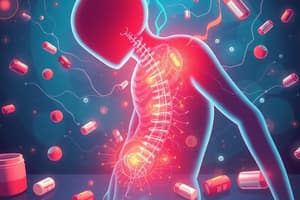Podcast
Questions and Answers
A patient with a history of asthma is prescribed a medication for hypertension. Which of the following medications would be most concerning for this patient, requiring careful evaluation before administration?
A patient with a history of asthma is prescribed a medication for hypertension. Which of the following medications would be most concerning for this patient, requiring careful evaluation before administration?
- Tamsulosin
- Propranolol (correct)
- Dopamine
- Epinephrine
A patient is prescribed lithium for bipolar disorder. Which of the following instructions is most crucial to emphasize regarding sodium and hydration to ensure medication safety and effectiveness?
A patient is prescribed lithium for bipolar disorder. Which of the following instructions is most crucial to emphasize regarding sodium and hydration to ensure medication safety and effectiveness?
- "Avoid drinking water to prevent diluting the lithium levels."
- "Restrict your sodium intake to prevent fluid retention."
- "Maintain a consistent sodium intake and stay well-hydrated." (correct)
- "Increase your sodium intake to avoid lithium toxicity."
A patient is receiving vancomycin intravenously. The nurse observes the patient developing a flushed appearance and a rash on their upper body. What is the most appropriate initial action for the nurse to take?
A patient is receiving vancomycin intravenously. The nurse observes the patient developing a flushed appearance and a rash on their upper body. What is the most appropriate initial action for the nurse to take?
- Administering an antihistamine immediately
- Administering epinephrine stat
- Slowing the infusion rate of vancomycin (correct)
- Discontinuing the vancomycin infusion immediately
A patient with a history of peptic ulcer disease is prescribed a nonsteroidal anti-inflammatory drug (NSAID) for pain management. Which of the following NSAIDs would be most concerning for this patient, requiring careful consideration of alternative options?
A patient with a history of peptic ulcer disease is prescribed a nonsteroidal anti-inflammatory drug (NSAID) for pain management. Which of the following NSAIDs would be most concerning for this patient, requiring careful consideration of alternative options?
A patient is prescribed ciprofloxacin. Which statement made by the patient indicates a need for further teaching regarding this medication?
A patient is prescribed ciprofloxacin. Which statement made by the patient indicates a need for further teaching regarding this medication?
A patient is taking an antipsychotic medication and develops tardive dyskinesia. Which of the following assessment findings is most indicative of this condition?
A patient is taking an antipsychotic medication and develops tardive dyskinesia. Which of the following assessment findings is most indicative of this condition?
A patient with Alzheimer's disease is prescribed donepezil. Which of the following nursing interventions is most important to implement to ensure patient safety and medication effectiveness?
A patient with Alzheimer's disease is prescribed donepezil. Which of the following nursing interventions is most important to implement to ensure patient safety and medication effectiveness?
A patient is started on levodopa for Parkinson's disease. Which dietary restriction should the nurse emphasize to maximize the effectiveness of the medication?
A patient is started on levodopa for Parkinson's disease. Which dietary restriction should the nurse emphasize to maximize the effectiveness of the medication?
Which of the following assessment findings would be most concerning in a patient receiving amphotericin B?
Which of the following assessment findings would be most concerning in a patient receiving amphotericin B?
A patient is prescribed an SSRI for depression. What is the most important information to emphasize regarding the onset of therapeutic effects and potential risks?
A patient is prescribed an SSRI for depression. What is the most important information to emphasize regarding the onset of therapeutic effects and potential risks?
A patient taking carbamazepine requires regular monitoring of which laboratory values due to potential adverse effects?
A patient taking carbamazepine requires regular monitoring of which laboratory values due to potential adverse effects?
A patient is prescribed tamsulosin. The nurse should provide which of the following instructions regarding its administration and potential side effects?
A patient is prescribed tamsulosin. The nurse should provide which of the following instructions regarding its administration and potential side effects?
A patient is receiving an aminoglycoside antibiotic. Which of the following assessment findings is most indicative of ototoxicity, a potential adverse effect of this medication?
A patient is receiving an aminoglycoside antibiotic. Which of the following assessment findings is most indicative of ototoxicity, a potential adverse effect of this medication?
A patient is prescribed nystatin suspension for oral candidiasis. What instructions should the nurse provide to the patient for proper administration?
A patient is prescribed nystatin suspension for oral candidiasis. What instructions should the nurse provide to the patient for proper administration?
A patient is prescribed flumazenil. The nurse understands this medication is used for the reversal of:
A patient is prescribed flumazenil. The nurse understands this medication is used for the reversal of:
After administering naloxone to a patient experiencing opioid overdose, the nurse should prioritize which of the following assessments?
After administering naloxone to a patient experiencing opioid overdose, the nurse should prioritize which of the following assessments?
A patient is prescribed cyclobenzaprine. Which of the following instructions is most important to emphasize regarding potential side effects and activities?
A patient is prescribed cyclobenzaprine. Which of the following instructions is most important to emphasize regarding potential side effects and activities?
Which of the following nursing interventions is most important to implement for a patient experiencing mucositis as a result of antineoplastic (chemotherapy) treatment?
Which of the following nursing interventions is most important to implement for a patient experiencing mucositis as a result of antineoplastic (chemotherapy) treatment?
A patient is prescribed sumatriptan for migraine headaches. Which of the following pre-administration assessments is the most important?
A patient is prescribed sumatriptan for migraine headaches. Which of the following pre-administration assessments is the most important?
A patient is prescribed an enteric-coated medication. What is the most important instruction the nurse should provide to the patient regarding its administration?
A patient is prescribed an enteric-coated medication. What is the most important instruction the nurse should provide to the patient regarding its administration?
Flashcards
NSAIDs Uses
NSAIDs Uses
Mild to moderate pain relief; also used for fever, rheumatoid arthritis (RA), osteoarthritis (OA), and dysmenorrhea.
Opioids Use
Opioids Use
Severe pain relief, commonly used as an adjunct to anesthesia.
Opioids Risks
Opioids Risks
Respiratory depression, constipation, sedation, and potential for dependence.
Antivirals Monitoring
Antivirals Monitoring
Signup and view all the flashcards
Azoles Toxicity
Azoles Toxicity
Signup and view all the flashcards
Adrenergic Agonists Action
Adrenergic Agonists Action
Signup and view all the flashcards
Alpha Blockers Use
Alpha Blockers Use
Signup and view all the flashcards
Beta Blockers Considerations
Beta Blockers Considerations
Signup and view all the flashcards
Atypical Antipsychotics Risks
Atypical Antipsychotics Risks
Signup and view all the flashcards
SSRIs Onset & Risk
SSRIs Onset & Risk
Signup and view all the flashcards
Lithium Therapeutic & Monitoring
Lithium Therapeutic & Monitoring
Signup and view all the flashcards
Benzodiazepines Risks
Benzodiazepines Risks
Signup and view all the flashcards
Myelosuppression Effects
Myelosuppression Effects
Signup and view all the flashcards
Vancomycin & Red Man Syndrome
Vancomycin & Red Man Syndrome
Signup and view all the flashcards
Levodopa Considerations
Levodopa Considerations
Signup and view all the flashcards
Donepezil Monitoring
Donepezil Monitoring
Signup and view all the flashcards
Sumatriptan Use & Assessment
Sumatriptan Use & Assessment
Signup and view all the flashcards
Rights of Medication Administration
Rights of Medication Administration
Signup and view all the flashcards
Enteric-Coated Tablets
Enteric-Coated Tablets
Signup and view all the flashcards
ABCs Priority
ABCs Priority
Signup and view all the flashcards
Study Notes
- Opioids and NSAIDs are used to treat pain but have different mechanisms and risks.
NSAIDs
- NSAIDs include ibuprofen, naproxen, diclofenac, indomethacin, meloxicam, celecoxib, and ketorolac.
- They treat mild to moderate pain, fever, rheumatoid arthritis, osteoarthritis, and dysmenorrhea.
- Contraindications include sulfa allergy (for celecoxib), GI bleed, renal or liver issues, and pregnancy.
Opioids
- Opioids include fentanyl, morphine, and hydromorphone.
- They treat severe pain and are used as anesthesia adjuncts.
- Risks include respiratory depression, constipation, sedation, and dependence.
- Monitor respiratory rate and hold if it is less than 8.
- Naloxone (Narcan) is the antidote for opioids.
Antibiotics
- Aminoglycosides (gentamicin) can cause nephrotoxicity and ototoxicity; monitor peak and trough levels.
- Penicillins and cephalosporins have a cross-allergy risk.
- Fluoroquinolones (ciprofloxacin) carry a black box warning for tendon rupture; avoid taking with antacids.
- Tetracyclines are not for children under 8, cause photosensitivity, and should be taken on an empty stomach.
Antivirals
- Antivirals (acyclovir, oseltamivir) typically end in "-vir"; monitor renal function.
Antifungals
- Azoles (-azole) can cause liver toxicity.
- Amphotericin B can cause nephrotoxicity; monitor BUN and creatinine.
- Nystatin is used orally or topically for candidiasis.
Narcotic Antagonists & Antidotes
- Naloxone (Narcan) is the antidote for opioid overdose.
- Flumazenil is the antidote for benzodiazepine overdose.
- Always assess airway, breathing, and circulation after administration of antagonists.
Adrenergic & Adrenergic Blocking Agents
- Adrenergic agonists (epinephrine, norepinephrine, dopamine) increase heart rate and blood pressure.
- Alpha blockers (-sin, e.g., tamsulosin) are used for benign prostatic hyperplasia (BPH).
- Beta blockers (-lol, e.g., propranolol) require monitoring of heart rate and blood pressure and are contraindicated in asthma, and watch for bradycardia, hypotension, and fatigue.
Psych Meds
- Typical antipsychotics (Haldol) carry a risk of extrapyramidal symptoms (EPS).
- Atypical antipsychotics (Risperdal, Abilify) can cause weight gain and QT prolongation.
- SSRIs (sertraline, fluoxetine) take 4–6 weeks to take effect and have an early risk of suicide.
- Lithium's therapeutic range is 0.6–1.2 mEq/L; monitor sodium levels and watch for toxicity symptoms.
- Benzodiazepines (diazepam, lorazepam) cause sedation and increase fall risk.
Muscle Relaxants
- Centrally acting muscle relaxants (cyclobenzaprine, baclofen) cause sedation and dizziness.
- Patients should avoid driving and should avoid alcohol and CNS depressants while taking these medications.
Antineoplastics (Chemo) Adverse Effects
- Myelosuppression can result in anemia, leukopenia, and thrombocytopenia.
- GI effects include nausea, vomiting, diarrhea, and mucositis; maintain oral hygiene and use antiemetics.
- Monitor labs and electrolytes for neuro, renal, and cardiac toxicity.
- Other effects include alopecia and sexual changes.
Med-Specific Nursing Considerations
- Vancomycin can cause Red Man Syndrome; slow the infusion to prevent this.
- Ciprofloxacin: Avoid antacids, risk of phototoxicity and tendon rupture.
- Aspirin carries a GI bleed risk and the risk of Reye’s syndrome in children.
- Donepezil is used for Alzheimer's; assess patient's orientation.
Other Meds
- Parkinson’s medications (Levodopa): Avoid high protein intake and take fall precautions.
- Alzheimer's medications (Donepezil): Assess orientation and ensure safety.
- Migraine medications (Sumatriptan): Take at the onset of a migraine and assess cardiac function.
- Seizure medications (phenytoin, valproic acid) have CNS side effects; monitor liver function.
Common Labs & Toxicities
- Lithium levels should be 0.6–1.2 mEq/L; monitor sodium and hydration.
- Valproic acid requires monitoring of liver enzymes.
- Carbamazepine requires monitoring of CBC and liver function.
- Amphotericin B requires monitoring of BUN and creatinine.
Miscellaneous & Priority Nursing Concepts
- The rights of medication administration: right patient, drug, dose, time, and route.
- Enteric-coated medications should not be crushed or chewed.
- Prioritize airway, breathing, and circulation (ABCs) first.
- When providing further teaching, look for incorrect statements to correct.
Studying That Suits You
Use AI to generate personalized quizzes and flashcards to suit your learning preferences.




